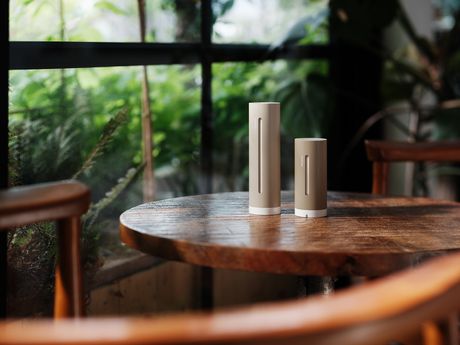
Netatmo presenta la nuova Stazione Meteo ORIGINAL

Fino al 50% di sconto su una selezione di prodottiAcquista

All'interno di un'abitazione il rischio di propagazione di un incendio è sempre in agguato. Impianti elettrici difettosi, elettrodomestici di bassa qualità, fiamme e braci libere come candele, incensi, fuoco dei fornelli… queste e altre fonti possono innescare reazioni a catena e portare alla formazione di scintille o veri e propri roghi. Una volta esploso, l'incendio è in grado di devastare la casa a una velocità sorprendente, causando gravi danni all'immobile ma anche alle proprietà nelle immediate vicinanze. La scelta di collocare un estintore in cucina, in soggiorno o in altre stanze rimane discrezionale, perché al momento non esiste alcun obbligo di legge in proposito, né da parte degli inquilini né dei proprietari, quantomeno per le abitazioni private o in affitto. Occorre tuttavia notare come, in assenza di un sistema antincendio idoneo quale appunto l'estintore, un eventuale incendio gestito male (ad esempio gettando acqua in presenza di cablaggi elettrici) potrebbe causare ulteriori guasti e ferimenti. Ecco perché l'estintore, con le sue dimensioni compatte e la sua proverbiale maneggevolezza, è un perfetto estinguente per affrontare almeno le fasi iniziali di un incendio.
Esistono diverse classi di estintori a seconda del tipo di incendio da controllare. Per la casa, è consigliato un estintore che combina la classe A (fuochi a secco - a causa di legna, carta, ecc.), la classe B (fuochi grassi - benzina, alcool, ecc.) e la classe C (fuochi a gas - gas naturale, ad esempio). Tra l'altro, un estintore domestico deve essere in grado di agire su incendi di origine elettrica!
Se i primi estintori erano apparecchiature piuttosto rudimentali realizzati con miscele in pressione, oggi il mercato si è evoluto non poco, diversificando le tipologie di estintori domestici in base alle classi di rischio, alla soluzione contenuta nel serbatoio, alla qualità costruttiva e così via. Ciascuna variante presenta svantaggi e svantaggi che è bene conoscere prima dell'acquisto. Vediamo allora le quattro alternative principali di estintore per domare incendi e roghi in casa.
L'estintore a polvere è tra i modelli più venduti per la casa, complice la polvere chimica al suo interno, una miscela capace di soffocare le fiamme e inibire la produzione di biossido di carbonio. Le classi coperte dagli estintori a polvere sono tutte tranne la F (olio e grassi da cucina), per cui solidi (classe A), liquidi (classe B), gas (classe C), metalli (classe D) e apparecchi elettrici (classe E). Il grosso svantaggio di questi estintori è il potenziale danneggiamento delle superfici della casa e la poco visibilità al momento dell'utilizzo dovuta alla pressione della polvere.
Un secondo modello di estintore è quello cosiddetto ad acqua: il nome potrebbe trarre in inganno, perché in effetti l'acqua non è l'unico componente. A questa viene aggiunto un additivo con ottime capacità di soffocamento del fuoco, ma con la controindicazione di risultare irritante a contatto con gli occhi e le mucose. Per quanto riguarda le classi, a differenza dell'estinguente in polvere la formulazione acqua e additivo è valida solo per i solidi (classe A) e i liquidi (classe B).
Altra possibilità valida è quella dell'estintore a gas. Quelli a gas sono estintori che soffocano l'incendio riducendo la quantità di ossigeno presente nell'aria. Il funzionamento è abbastanza semplice e pulito, in quanto si evita la propagazione di polveri, liquidi e quant'altro. Lo svantaggio maggiore è che il gas, essendo in pressione, subisce un repentino abbassamento della temperatura, fino a volte a congelare le superfici con cui viene a contatto. Meno versatile della polvere estinguente, il gas è idoneo per applicazioni di classe B (liquidi), C (gas), ed E (apparecchi elettrici).
L'ultima delle quattro tipologie di estintori è quella a schiuma. La sostanza schiumogena può essere di due tipi, ovvero chimica (basata sulla reazione base – acido di due sostanze) oppure meccanica, con l'anidride carbonica che espelle il liquido. Un accessorio in questo caso indicato per domare le fiamme su solidi (classe A) e liquidi (classe B).
Sono quattro i fattori che incidono sul costo esatto e sulle prestazioni dell'estintore, anche in considerazione di dove e come avviene l'installazione. Se devi comprare un estintore, allora ti conviene tenere presente anche questi aspetti:
In base alla capacità, l'estintore sarà più o meno pesante, con un range che spazia da 1 kg a 6-7 o anche 10 kg. Va da sé che più un estintore è maneggevole, più sarà facile usarlo, ma con meno riserve di liquido, schiuma o gas a disposizione.
Gli estintori possono essere lunghi e sottili oppure più tozzi e corti, in relazione allo spazio in cui verranno collocati (tipicamente una nicchia, ma nelle case è più verosimile un armadio o la parete della stanza). Anche qui va capito dove posizionare l'estintore prima di comprarlo.
Gli estintori, in Italia, devono essere approvati dal Ministero dell’Interno secondo la norma del D.M. 7/01/05. Il processo di controllo qualità del serbatoio deve rispondere invece alla normativa ISO 9001.
Rimane a questo punto da stabilire il prezzo. Viste le dimensioni, vista la collocazione e vista la garanzia, il ventaglio di spesa per l'acquisto di un estintore portatile oscilla dai 20 euro minimo per i modelli più compatti ai 100 euro e oltre per le versioni più capienti e sofisticate. Oggi come oggi esistono anche siti web da cui ordinare l'estintore per averlo in casa nell'arco di 48-72 ore. Nella valutazione è indispensabile calcolare le dimensioni dell'immobile, le distanze tra un estintore e l'altro, la presenza di zone ad alto rischio (caminetti, stufe a gas, ecc), e tutto ciò che può entrare in gioco nel momento del pericolo.